

E-Books → Gonick L The Cartoon Guide to Geometry 2024
Published by: Emperor2011 on 11-02-2024, 04:29 |  0
0

Gonick L The Cartoon Guide to Geometry 2024 | 157.79 MB
N/A | 273 Pages
Title: The Cartoon Guide to Geometry
Author: Larry Gonick
Year: N/A
E-Books → Progress in Inverse Spectral Geometry
Published by: voska89 on 2-02-2024, 05:01 |  0
0
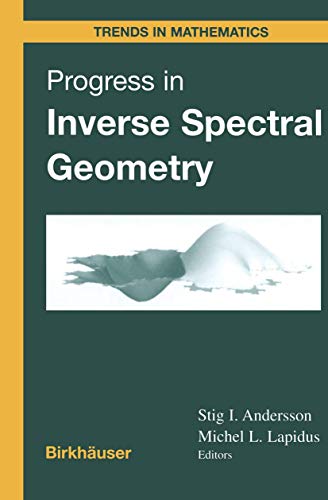
Free Download Progress in Inverse Spectral Geometry by Stig I. Andersson, Michel L. Lapidus
English | PDF | 1997 | 202 Pages | ISBN : 376435755X | 26 MB
most polynomial growth on every half-space Re (z) ::::: c. Moreover, Op(t) depends holomorphically on t for Re t > O. General references for much of the material on the derivation of spectral functions, asymptotic expansions and analytic properties of spectral functions are [A-P-S] and [Sh], especially Chapter 2. To study the spectral functions and their relation to the geometry and topology of X, one could, for example, take the natural associated parabolic problem as a starting point. That is, consider the 'heat equation': (%t + p) u(x, t) = 0 { u(x,O) = Uo(x), tP which is solved by means of the (heat) semi group V(t) = e- ; namely, u(·, t) = V(t)uoU· Assuming that V(t) is of trace class (which is guaranteed, for instance, if P has a positive principal symbol), it has a Schwartz kernel K E COO(X x X x Rt,E* ®E), locally given by 00 K(x,y; t) = L>-IAk(~k ® 'Pk)(X,y), k=O for a complete set of orthonormal eigensections 'Pk E COO(E). Taking the trace, we then obtain: 00 tA Op(t) = trace(V(t)) = 2::>- k. k=O Now, using, e. g. , the Dunford calculus formula (where C is a suitable curve around a(P)) as a starting point and the standard for malism of pseudodifferential operators, one easily derives asymptotic expansions for the spectral functions, in this case for Op.
E-Books → Notions of Positivity and the Geometry of Polynomials (Repost)
Published by: voska89 on 2-02-2024, 05:00 |  0
0
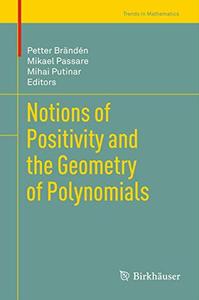
Free Download Notions of Positivity and the Geometry of Polynomials by Petter Brändén, Mikael Passare, Mihai Putinar
English | PDF (True) | 2011 | 413 Pages | ISBN : 3034801416 | 7.3 MB
The book consists of solicited articles from a select group of mathematicians and physicists working at the interface between positivity and the geometry, combinatorics or analysis of polynomials of one or several variables. It is dedicated to the memory of Julius Borcea (1968-2009), a distinguished mathematician, Professor at the University of Stockholm. With his extremely original contributions and broad vision, his impact on the topics of the planned volume cannot be underestimated. All contributors knew or have exchanged ideas with Dr. Borcea, and their articles reflect, at least partially, his heritage.
E-Books → Advances in Analysis and Geometry New Developments Using Clifford Algebras
Published by: voska89 on 2-02-2024, 04:51 |  0
0
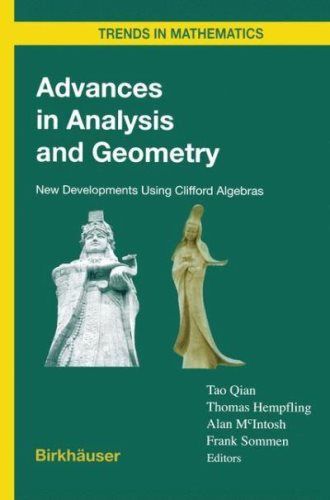
Free Download Advances in Analysis and Geometry: New Developments Using Clifford Algebras by Tao Qian, Thomas Hempfling, Alan McIntosh, Frank Sommen
English | PDF | 2004 | 308 Pages | ISBN : 3764366613 | 49 MB
On the 16th of October 1843, Sir William R. Hamilton made the discovery of the quaternion algebra H = qo + qli + q2j + q3k whereby the product is determined by the defining relations ·2 ·2 1 Z =] = - , ij = -ji = k. In fact he was inspired by the beautiful geometric model of the complex numbers in which rotations are represented by simple multiplications z --t az. His goal was to obtain an algebra structure for three dimensional visual space with in particular the possibility of representing all spatial rotations by algebra multiplications and since 1835 he started looking for generalized complex numbers (hypercomplex numbers) of the form a + bi + cj. It hence took him a long time to accept that a fourth dimension was necessary and that commutativity couldn't be kept and he wondered about a possible real life meaning of this fourth dimension which he identified with the scalar part qo as opposed to the vector part ql i + q2j + q3k which represents a point in space.
E-Books → Quantum Theories and Geometry
Published by: voska89 on 30-01-2024, 07:40 |  0
0

Free Download Quantum Theories and Geometry by M. Cahen, M. Flato
English | PDF | 1988 | 196 Pages | ISBN : 9027728038 | 12.1 MB
This book presents the text of most of the lectures which were de livered at the Meeting Quantum Theories and Geometry which was held at the Fondation Les Treilles from March 23 to March 27, 1987. The general aim of this meeting was to bring together mathemati cians and physicists who have worked in this growing field of contact between the two disciplines, namely this region where geometry and physics interact creatively in both directions. It 1S the strong belief of the organizers that these written con tributions will be a useful document for research people workin~ 1n geometry or physics. Three lectures were devoted to the deformation approach to quantum mechanics which involves a modification of both the associative and the Lie structure of the algebra of functions on classical phase space. A.Lichnerowicz shows how one can view classical and quantum statistical mechanics in terms of a deformation with a parameter inversely propor tional to temperature. S.Gutt reviews the physical background of star products and indicates their applications in Lie groups representa tion theory and in harmonic analysis. D.Arnal gives a rigorous theory Vll viii PREFACI of the star exponential in the case of the Heisenberg group and shows how this can be extended to arbitrary nilpotent groups.
E-Books → Precalculus Mathematics in a Nutshell Geometry, Algebra, Trigonometry
Published by: voska89 on 30-01-2024, 07:38 |  0
0
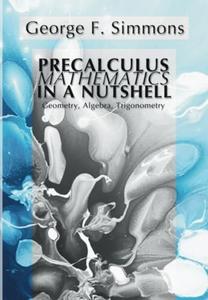
Free Download Precalculus Mathematics in a Nutshell: Geometry, Algebra, Trigonometry By George F. Simmons
2003 | 128 Pages | ISBN: 1592441300 | PDF | 16 MB
"Geometry is a very beautiful subject whose qualities of elegance, order, and certainty have exerted a powerful attraction on the human mind for many centuries . . . Algebra's importance lies in the student's future . . . as essential preparation for the serious study of science, engineering, economics, or for more advanced types of mathematics . . . The primary importance of trigonometry is not in its applications to surveying and navigation, or in making computations about triangles, but rather in the mathematical description of vibrations, rotations, and periodic phenomena of all kinds, including light, sound, alternating currents, and the orbits of the planets around the sun" In this brief, clearly written book, the essentials of geometry, algebra, and trigonometry are pulled together into three complementary and convenient small packages, providing an excellent preview and review for anyone who wishes to prepare to master calculus with a minimum of misunderstanding and wasted time and effort. Students and other readers will find here all they need to pull them through.
E-Books → Orthogonality and Spacetime Geometry
Published by: voska89 on 30-01-2024, 07:35 |  0
0
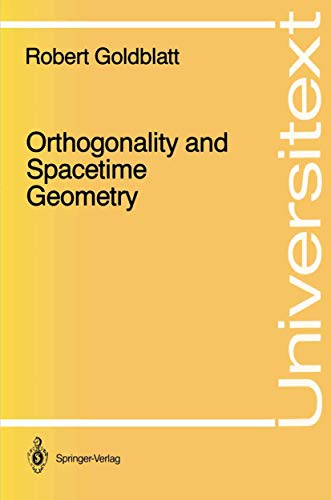
Free Download Orthogonality and Spacetime Geometry by Robert Goldblatt
English | PDF | 1987 | 199 Pages | ISBN : 038796519X | 13.3 MB
This book examines the geometrical notion of orthogonality, and shows how to use it as the primitive concept on which to base a metric structure in affine geometry. The subject has a long history, and an extensive literature, but whatever novelty there may be in the study presented here comes from its focus on geometries hav ing lines that are self-orthogonal, or even singular (orthogonal to all lines). The most significant examples concern four-dimensional special-relativistic spacetime (Minkowskian geometry), and its var ious sub-geometries, and these will be prominent throughout. But the project is intended as an exercise in the foundations of geome try that does not presume a knowledge of physics, and so, in order to provide the appropriate intuitive background, an initial chapter has been included that gives a description of the different types of line (timelike, spacelike, lightlike) that occur in spacetime, and the physical meaning of the orthogonality relations that hold between them. The coordinatisation of affine spaces makes use of constructions from projective geometry, including standard results about the ma trix represent ability of certain projective transformations (involu tions, polarities). I have tried to make the work sufficiently self contained that it may be used as the basis for a course at the ad vanced undergraduate level, assuming only an elementary knowledge of linear and abstract algebra.
E-Books → Notes on Geometry
Published by: voska89 on 30-01-2024, 07:33 |  0
0
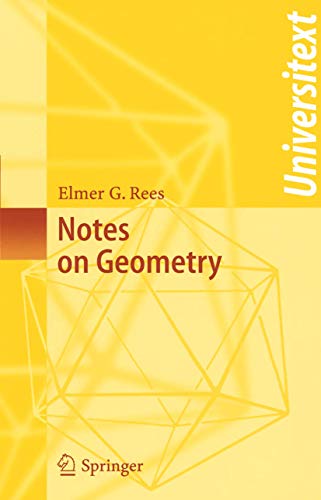
Free Download Notes on Geometry by Elmer G. Rees
English | PDF | 1983 | 119 Pages | ISBN : 354012053X | 8.4 MB
In recent years, geometry has played a lesser role in undergraduate courses than it has ever done. Nevertheless, it still plays a leading role in mathematics at a higher level. Its central role in the history of mathematics has never been disputed. It is important, therefore, to introduce some geometry into university syllabuses. There are several ways of doing this, it can be incorporated into existing courses that are primarily devoted to other topics, it can be taught at a first year level or it can be taught in higher level courses devoted to differential geometry or to more classical topics. These notes are intended to fill a rather obvious gap in the literature. It treats the classical topics of Euclidean, projective and hyperbolic geometry but uses the material commonly taught to undergraduates: linear algebra, group theory, metric spaces and complex analysis. The notes are based on a course whose aim was two fold, firstly, to introduce the students to some geometry and secondly to deepen their understanding of topics that they have already met. What is required from the earlier material is a familiarity with the main ideas, specific topics that are used are usually redone.
E-Books → Modern Geometry – Methods and Applications Part I. The Geometry of Surfaces, Transformation Groups, and Fields
Published by: voska89 on 30-01-2024, 07:31 |  0
0
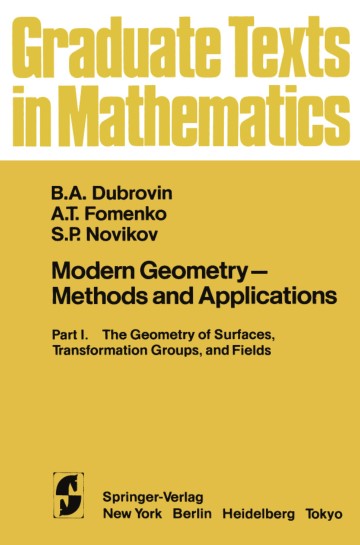
Free Download Modern Geometry - Methods and Applications: Part I. The Geometry of Surfaces, Transformation Groups, and Fields by B. A. Dubrovin , A. T. Fomenko , S. P. Novikov
English | PDF | 1984 | 479 Pages | ISBN : N/A | 35.6 MB
manifolds, transformation groups, and Lie algebras, as well as the basic concepts of visual topology. It was also agreed that the course should be given in as simple and concrete a language as possible, and that wherever practic able the terminology should be that used by physicists. Thus it was along these lines that the archetypal course was taught. It was given more permanent form as duplicated lecture notes published under the auspices of Moscow State University as: Differential Geometry, Parts I and II, by S. P. Novikov, Division of Mechanics, Moscow State University, 1972. Subsequently various parts of the course were altered, and new topics added. This supplementary material was published (also in duplicated form) as Differential Geometry, Part III, by S. P. Novikov and A. T. Fomenko, Division of Mechanics, Moscow State University, 1974. The present book is the outcome of a reworking, re-ordering, and ex tensive elaboration of the above-mentioned lecture notes. It is the authors' view that it will serve as a basic text from which the essentials for a course in modern geometry may be easily extracted. To S. P. Novikov are due the original conception and the overall plan of the book. The work of organizing the material contained in the duplicated lecture notes in accordance with this plan was carried out by B. A. Dubrovin.
E-Books → Integrability and Nonintegrability in Geometry and Mechanics
Published by: voska89 on 30-01-2024, 07:18 |  0
0

Free Download Integrability and Nonintegrability in Geometry and Mechanics by A. T. Fomenko
English | PDF | 1988 | 358 Pages | ISBN : 9027728186 | 28.7 MB
Approach your problems from the right end It isn't that they can't see the solution. It is and begin with the answers. 1hen one day, that they can't see the problem. perhaps you will find the final question. G. K. Chesterton. The Scandal of Father 'The Hermit Oad in Crane Feathers' in R. Brown 'The point of a Pin' . * 1111 Oulik'. n. . Chi" *. * ~ Mm~ Mu,d. ", Growing specialization and diversification have brought a host of monographs and textbooks on increasingly specialized topics. However, the "tree" of knowledge of mathematics and related fields does not grow only by putting forth new branches. It also happens, quite often in fact, that branches which were thought to be completely disparate are suddenly seen to be related. Further, the kind and level of sophistication of mathematics applied in various sciences has changed drastically in recent years: measure theory is used (non-trivially) in regional and theoretical economics; algebraic geometry interacts with physics; the Minkowsky lemma, coding theory and the structure of water meet one another in packing and covering theory; quantum fields, crystal defects and mathematical programming profit from homotopy theory; Lie algebras are relevant to filtering; and prediction and electrical engineering can use Stein spaces. And in addition to this there are such new emerging subdisciplines as "experimental mathematics", "CFD", "completely integrable systems", "chaos, synergetics and large-scale order", which are almost impossible to fit into the existing classification schemes. They draw upon widely different sections of mathematics.



